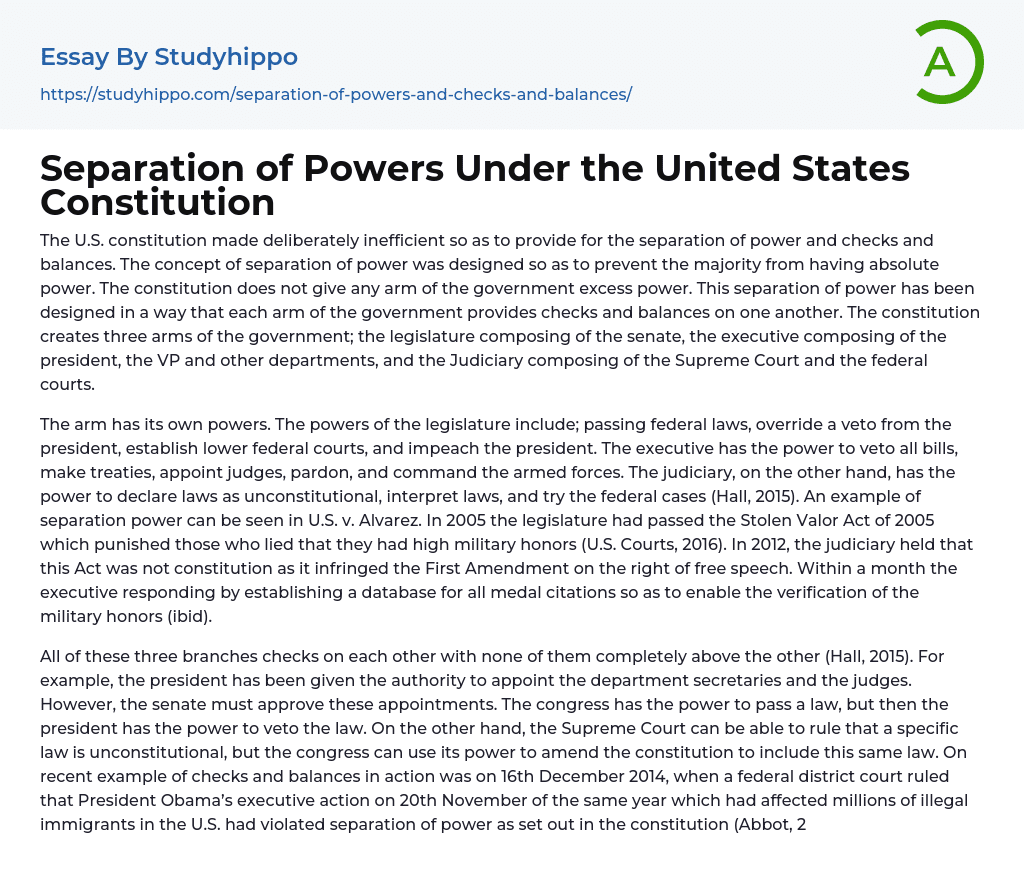

Separation of Powers Under the United States Constitution Essay Example
The U.S. constitution made deliberately inefficient so as to provide for the separation of power and checks and balances. The concept of separation of power was designed so as to prevent the majority from having absolute power. The constitution does not give any arm of the government excess power. This separation of power has been designed in a way that each arm of the government provides checks and balances on one another. The constitution creates three arms of the government; the legislature composing of the senate, the executive composing of the president, the VP and other departments, and the Judiciary composing of the Supreme Court and the federal courts.
The arm has its own powers. The powers of the legislature include; passing federal laws, override a veto from the president, establish lower federal courts, and im
...peach the president. The executive has the power to veto all bills, make treaties, appoint judges, pardon, and command the armed forces. The judiciary, on the other hand, has the power to declare laws as unconstitutional, interpret laws, and try the federal cases (Hall, 2015). An example of separation power can be seen in U.S. v. Alvarez. In 2005 the legislature had passed the Stolen Valor Act of 2005 which punished those who lied that they had high military honors (U.S. Courts, 2016). In 2012, the judiciary held that this Act was not constitution as it infringed the First Amendment on the right of free speech. Within a month the executive responding by establishing a database for all medal citations so as to enable the verification of the military honors (ibid).
All of these three branches checks on each other with none
of them completely above the other (Hall, 2015). For example, the president has been given the authority to appoint the department secretaries and the judges. However, the senate must approve these appointments. The congress has the power to pass a law, but then the president has the power to veto the law. On the other hand, the Supreme Court can be able to rule that a specific law is unconstitutional, but the congress can use its power to amend the constitution to include this same law. On recent example of checks and balances in action was on 16th December 2014, when a federal district court ruled that President Obama’s executive action on 20th November of the same year which had affected millions of illegal immigrants in the U.S. had violated separation of power as set out in the constitution (Abbot, 2014).
The constitution provides for separation of power through a system of checks and balances. Although the checks and balances provided are not sufficient, this is deliberate and not by accident. This was to ensure that each arm of the government is accountable to each other. This prevents the majority from having excessive power and therefore preventing them from ruling with an iron fist.
References
- Abbott, A. (2014). Fed. Judge: Obama’s Immigration Action ‘Violates the Separation of
Powers’. CNS News. Retrieved 21 July 2016, from
http://www.cnsnews.com/commentary/alden-abbott/fed-judge-obama-s-immigration-
action-violates-separation-powers - Hall, K.L. (2015). The Least Dangerous Branch: Separation of Powers and Court-Packing: The
Supreme Court in American Society. London: Routledge. - US Courts. (2016). Separation of Powers in Action - U.S. v. Alvarez. United States Courts.
Retrieved 21 July 2016, from http://www.uscourts.gov/educational-
resources/educational-activities/separation-powers-action-us-v-alvarez
- First Amendment essays
- Bill Of Rights essays
- Civil Liberties essays
- First Amendment To The United States Constitution essays
- Fourth Amendment To The United States Constitution essays
- Second amendment essays
- Bureaucracy essays
- Congress essays
- President essays
- Separation Of Powers essays
- United States Congress essays



